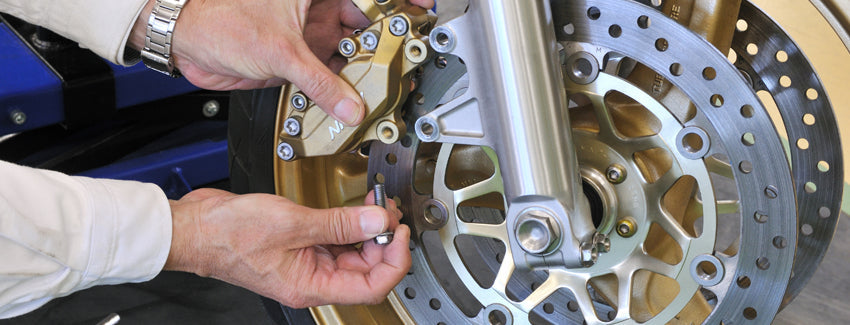| A motorcycle that won't start is much less of a problem than a motorcycle that won't stop. When you grab the grip and push the pedal to apply brakes to your bike, you stop the bike. |
| On a motorcycle, the amount of braking power you get per wheel varies. A New Zealand website that offers sample driver's license tests says the front wheel delivers 75-90 percent of the braking power. The braking power varies by bike, it says. "A sport bike will take more braking on the front wheel, whereas a cruiser carries more weight over the rear wheel and will have more braking power in the rear wheel. As you brake the weight shifts forwards over the front wheel. This lightens the load on the rear wheel and makes it more difficult for it to achieve any braking power." |
| We took a look at the stopping power of brakes in Part I. |
| But what are the brakes made of? |
| The actual brakes that slow and stop a bike are in two major parts and several smaller parts. The major parts are the two that actually provide the stopping power. Everything else is supporting structure, but still important. |
| ROTOR |
| This is the disk that mounts to the bike's wheel. It has holes in it to help get rid of the heat generated by the friction of braking. Holes also reduce the weight. Brakes with a rotor are called disk or disc brakes. |
| Rotors can be made from cast iron, steel or composites. CQuence makes high performance brakes and discusses the 6 main types in this article. Aluminum and aluminum composites are common rotor material for bikes. |
| The brake pads press against the rotor. This provides the friction to stop. |
| Rotors can be used front and back but are most common on the front only. |
| When doing maintenance, the rotor brakes are the easiest to examine. You can see the rotor and often the brake pads. You can tell quickly if either or both need to be replaced. |
| DRUM |
| Think of a pot when talking about drum brakes. The pot fits over the rear hub. Brake pads, or shoes, go inside the pot. When you press the brake, the shoes press against the inside of the pot. This slows your bike. |
| The drum is usually made from cast iron. |
| Maintenance requires removing the drum. On a motorcycle that often means removing the rear wheel. Drum brakes are harder to service than rotary brakes. |
| PADS & SHOES |
| Pads and shoes are two parts. One part is the pad itself, the part that touches the rotor or the drum. This wears away with use. The other part is the metal backing the pad is attached to. |
| The wearing surface can be made from a bunch of different materials. Motorcycle Central lists three main types. The organic brakes have three subcategories. Each has slightly different properties. |
| At one time, brake pads used asbestos as the wear material. This is much less common today because of the health hazards associated with asbestos. |
| OTHER PARTS |
| Brakes are much more than just pads and rotors. Brake fluid was explained in Part 1. |
| Brake cables are two kinds. One channels the brake fluid from the reservoir to the calipers. The calipers clamp the pads to the rotor. |
| The second uses a high-strength that runs to the caliper and pulls the pad against the rotor or drum. Just like brake fluid, the cable should be replaced from time to time. "The poor braking performance may be related to a poorly adjusted brake cable, stretched cable, worn or seized brake cam, or a combination of factors," says Mr. Cycles. |
| Other parts attach the cables to the bike and the pedal or grip. Bolts attach the drum or rotor to the wheel. |
Stopping Power: Last Guide to Brakes You’ll Ever Need – Part 2

Tags: Gear guides




